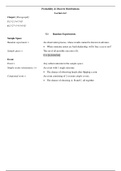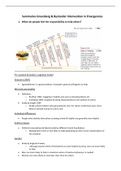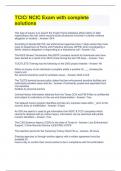Business Law, Antitrust and Industrial and Intellectual Property Law
IP: National vs International Law
- Intellectual property law refers to the law regulating rights and obligations in relation
to creations of the mind
- IP can be divided into 2 main categories:
o Industrial property – which includes patents, trademarks, industrial designs
and geographical indications and
o Copyright and related rights
- IP rights apply within territorial boundaries, but increasingly they are confronted
with the reality of modern global commerce in which market transactions
accommodate a host of different cross-border entities and activities.
- Value chains have become global, permeated by the movement of intangible capital
such as IP protected technology, design, branding, and literary and artistic works
- Rights granted by domestic patent, trademark or copyright extend only throughout
the territory of that country and have no effect in a foreign country
o As a consequence: an inventor/creator who wishes protection in other
countries must apply for an IP right in each of the other countries or in
regional offices.
- IP rights are by their nature territorially limited which means that IPR within a
country are independent of any such rights existing in other countries
o Example: If you register IP rights in Europe or elsewhere this will not provide
effective protection in China and will require different registration
procedures
- IPRs are territorial due to the fact that they are offered and governed by each
country’s own legislation. However, there are various international IP conventions
trying to harmonize or unify this sector of law.
o Problems: the internet – blurs the line in respect to jurisdiction and choice of
law
Different Laws
- The biggest dilemma = managing the varying laws in each individual country. While a
particular region may have protection agreements, each country regulates the actual
protection differently. The differences can even vary down to the type of IP.
- Copyrights may be handled differently than trademarks and patents. Although there
isn’t a common or global copyright protection, it is possible to protect your
copyrights overseas if your target country is a signatory of the various international
IP protection treaties – common treaties include the Berne Convention or the TRIPS
Agreement.
,IP Law Global/Regional Harmonization
- IP law is made up of intersecting multilateral and bilateral agreements and their
resulting harmonization of national laws
- It has become a frequently litigated area. In the past few decades, there has been
increasing demand for protection of domain names, databases, software and
traditional knowledge.
- Many of these cutting-edge IP issues are addressed on an international level through
the World IPO.
- IP is intangible and globally mobile, effortlessly transcending territorial boundaries,
in particular the increasingly online world. However, IP protection is territorial: the
scope of IP protection is determined by national law
Most Important International Agreements in IP Law
- Agreement on Trade-Related Aspects of IPRs (TRIPS)
- Berne Convention for the Protection of Literary and Artistic Works
- Hague Agreement Concerning the Deposit of Industrial Designs
- Madrid Agreement Concerning the International Registration of Trademark
- Paris Convention for the Protection of Industrial Property
- European Patent Convention
- Etc
Copyright
- Spanish Copyright Act: Royal Legislative Decree 1/1996
- Basic legal aspects on the protection of creative works, in all areas covered by
copyright from the literary, musical, theatrical, architectural, cinematographic and
figurative arts to software, databases and design work
- Copyright law especially connected to IT and tech AI
Patents
- New Spanish patent Act: Law 24/2015
- Legal aspects of the innovation sector, with particular regard to;
o Invention patents
o Biotech inventions
o Business methods patents
Trademarks and Bands
- Spanish TM Act: Law 17/2001
- Legal aspect on:
o National, European and international trademarks
o Trade names and logos
o Domain names
o Protected geographical indications and protected designations of origin
Design
- Spanish law 20/2003 on the Legal Protection of Industrial Design
- Protecting the external appearance of products
, - Protection of registered and unregistered designs and models
- Examples: IP and licensing arrangement
o IP rights can be transferred through licensing agreements
o Licensor grants permission to the licensee to use their IPR
Tangible vs Intangible
- How are tangible assets different from intangible assets?
Unfair Competition and Advertising
- The field of protection of fair competition between businesses in relation to:
o Look-alike products
o Slavish imitations
o Misleading practices
o Employee poaching
o And in general, all other unfair business practices
- Elements of competition law: 2 main elements
o Antitrust law
o Law of unfair competition
IP: National vs International Law
- Intellectual property law refers to the law regulating rights and obligations in relation
to creations of the mind
- IP can be divided into 2 main categories:
o Industrial property – which includes patents, trademarks, industrial designs
and geographical indications and
o Copyright and related rights
- IP rights apply within territorial boundaries, but increasingly they are confronted
with the reality of modern global commerce in which market transactions
accommodate a host of different cross-border entities and activities.
- Value chains have become global, permeated by the movement of intangible capital
such as IP protected technology, design, branding, and literary and artistic works
- Rights granted by domestic patent, trademark or copyright extend only throughout
the territory of that country and have no effect in a foreign country
o As a consequence: an inventor/creator who wishes protection in other
countries must apply for an IP right in each of the other countries or in
regional offices.
- IP rights are by their nature territorially limited which means that IPR within a
country are independent of any such rights existing in other countries
o Example: If you register IP rights in Europe or elsewhere this will not provide
effective protection in China and will require different registration
procedures
- IPRs are territorial due to the fact that they are offered and governed by each
country’s own legislation. However, there are various international IP conventions
trying to harmonize or unify this sector of law.
o Problems: the internet – blurs the line in respect to jurisdiction and choice of
law
Different Laws
- The biggest dilemma = managing the varying laws in each individual country. While a
particular region may have protection agreements, each country regulates the actual
protection differently. The differences can even vary down to the type of IP.
- Copyrights may be handled differently than trademarks and patents. Although there
isn’t a common or global copyright protection, it is possible to protect your
copyrights overseas if your target country is a signatory of the various international
IP protection treaties – common treaties include the Berne Convention or the TRIPS
Agreement.
,IP Law Global/Regional Harmonization
- IP law is made up of intersecting multilateral and bilateral agreements and their
resulting harmonization of national laws
- It has become a frequently litigated area. In the past few decades, there has been
increasing demand for protection of domain names, databases, software and
traditional knowledge.
- Many of these cutting-edge IP issues are addressed on an international level through
the World IPO.
- IP is intangible and globally mobile, effortlessly transcending territorial boundaries,
in particular the increasingly online world. However, IP protection is territorial: the
scope of IP protection is determined by national law
Most Important International Agreements in IP Law
- Agreement on Trade-Related Aspects of IPRs (TRIPS)
- Berne Convention for the Protection of Literary and Artistic Works
- Hague Agreement Concerning the Deposit of Industrial Designs
- Madrid Agreement Concerning the International Registration of Trademark
- Paris Convention for the Protection of Industrial Property
- European Patent Convention
- Etc
Copyright
- Spanish Copyright Act: Royal Legislative Decree 1/1996
- Basic legal aspects on the protection of creative works, in all areas covered by
copyright from the literary, musical, theatrical, architectural, cinematographic and
figurative arts to software, databases and design work
- Copyright law especially connected to IT and tech AI
Patents
- New Spanish patent Act: Law 24/2015
- Legal aspects of the innovation sector, with particular regard to;
o Invention patents
o Biotech inventions
o Business methods patents
Trademarks and Bands
- Spanish TM Act: Law 17/2001
- Legal aspect on:
o National, European and international trademarks
o Trade names and logos
o Domain names
o Protected geographical indications and protected designations of origin
Design
- Spanish law 20/2003 on the Legal Protection of Industrial Design
- Protecting the external appearance of products
, - Protection of registered and unregistered designs and models
- Examples: IP and licensing arrangement
o IP rights can be transferred through licensing agreements
o Licensor grants permission to the licensee to use their IPR
Tangible vs Intangible
- How are tangible assets different from intangible assets?
Unfair Competition and Advertising
- The field of protection of fair competition between businesses in relation to:
o Look-alike products
o Slavish imitations
o Misleading practices
o Employee poaching
o And in general, all other unfair business practices
- Elements of competition law: 2 main elements
o Antitrust law
o Law of unfair competition










